Simply Guitar vs Yousician: which online guitar lesson apps is best?
Comparing two of the most beginner-friendly and fun video game-style lesson apps

Playing the guitar is superb fun, after all it’s what many of us live for. It’s the best.
Learning to play the guitar, on the other hand, can really suck. Occasionally, progress comes so thick and fast it’s reward enough, yet often it seems that we’re just plodding on with little to show for our efforts. It can be downright frustrating if not a little dull. No wonder that, according to Fender, 90% of guitar students give up within three months.
Simply Guitar and Yousician are two online guitar lessons apps that promise to make learning the guitar a whole lot more fun. Both are reminiscent of video games, with bright lively graphics, points to be awarded, stars to be won and levels to be conquered. Notably, instead of using traditional video-based instruction tutorials, like platforms such as Justin Guitar and Fender Play, they both use an animated fretboard as their primary learning tool.
If you remember blazing your way through Guitar Hero as a kid, then you’ll feel right at home with either Simply Guitar or Yousician.
In this article we’re going to compare and contrast the two for features, usability, content and more to help you decide which is right for you.
Simply Guitar vs Yousician: At a glance

Bold, bright and brash, it’s easy to dismiss both Simply Guitar and Yousician as gimmicks. Don’t. On first impressions they may seem to offer all the sophistication of an arcade game, (or, more accurately, the lack of it) but dig a little deeper and you’ll discover efficient learning systems that challenge and reward in equal measure. They’re addictive.
Both provide a structured framework in which to learn, and both set achievable goals and rewards with praise and incentives. All the while making the whole process seem like a giggle-fest. What’s more, both platforms enable students to engage in little else but effective practice. It may feel like you’re just playing around but you’re actually completing something very worthwhile.
Get The Pick Newsletter
All the latest guitar news, interviews, lessons, reviews, deals and more, direct to your inbox!
Yousician can be enjoyed as an app on iOS and Android, or as a desktop application on MacOS and Windows.
There are three paid-for account levels – Premium, Premium+ Personal and Premium+ Family – together with a free option that gives you access to some very basic tuition. Paid-for access can be bought on monthly or yearly subscription, with the latter being substantially cheaper for frequent and regular users. You can sign up for a Premium+ seven day trial, which will be downgraded to a basic free account if you decide not to proceed.
- 7-day free trial
- Premium costs $89.99 billed annually or $7.49 billed monthly
- Premium+ Personal costs $139.99 billed annually or $11.66 billed monthly
- Premium+ Family costs $209.99 billed annually or $17.49 billed monthly
- Try Yousician
Simply Guitar is only available as an app for iOS and Android, there is currently no desktop version. There’s a free option that lets you work through a couple of basic levels, and Simply Guitar also offers a 14-day free trial of its Premium account. A paid-for Premium subscription can have up to five profiles per membership, which is very useful if anyone in your family is learning with you.
- In-App costs $119.99 billed annually for Premium Membership
- Download Simply Guitar
Both platforms require your devices to be equipped with an internal or external mic, and recommend that you wear headphones so that your guitar can be heard clearly above the lesson material.
Simply Guitar vs Yousician: Getting started
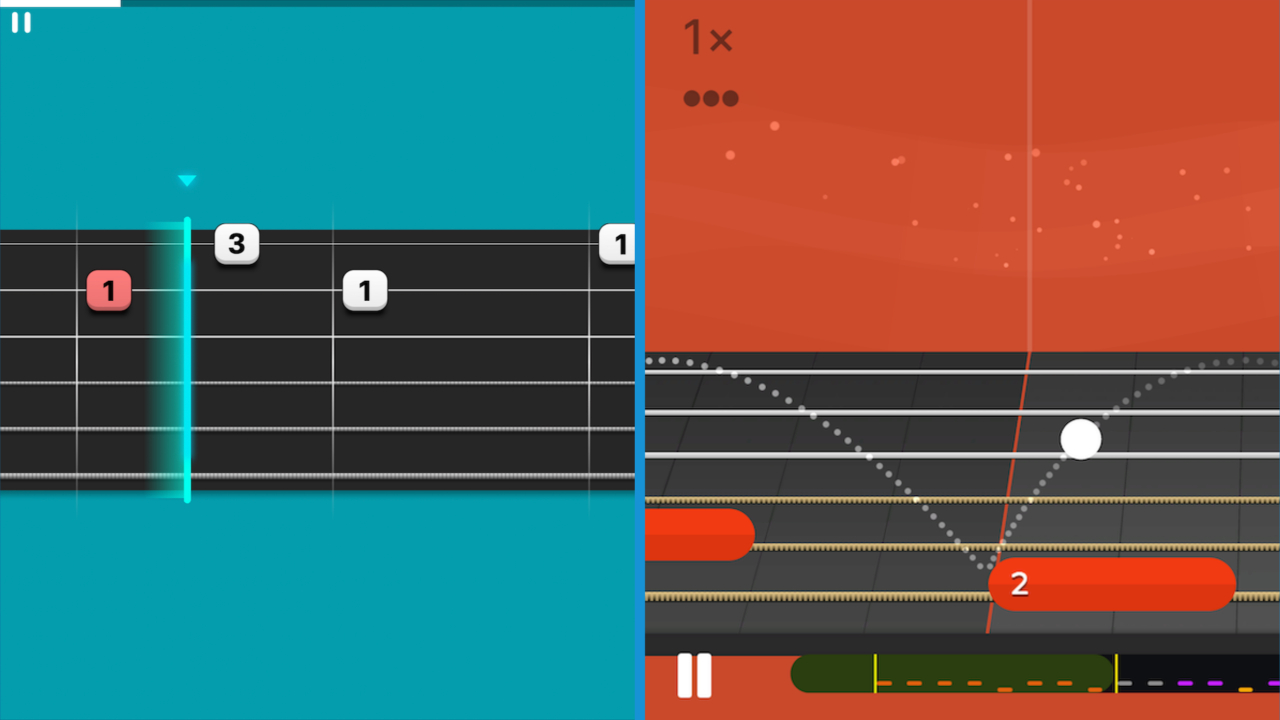
Signing up for either Simply Guitar or Yousician is very straightforward but there are some significant differences.
Head over to yousician.com and you’ll find a wealth of information about the application, plus a useful blog dedicated to learning how to play an instrument. It’s a great resource and a neat way to learn about the software before you agree to sign up.
Simply Guitar is, well, a lot more covert! Bring up simplyguitar.joytunes.com in your browser and you’ll just find a purple button urging you to get started. Its parent company, Simply (formally JoyTunes), does have a website that provides a little background about the app but that’s all. Fortunately, both the Apple App Store and the Google Play store do carry a brief description.
Sign up to Yousician from the web, and once you’ve passed the subscription options and created an account you’ll be invited to download the desktop application or switch to your mobile to make use of the mobile app.
Your guitar journey will begin right at the start of Yousician’s Learning Path, at a level appropriately named Basics. From here you can complete the initial, very rudimentary lessons or, if you’re a little more experienced, explore the rest of the content. A word of warning, if you do leave the pathway then it’s not immediately obvious where you should go next, or indeed, where you’ve been.
Unfortunately, there’s almost nothing in the way of in-app help. Instead, if you do get dazed or confused, the only option is to head back to the Yousician website to seek advice from its knowledge base.
Getting started with Simply Guitar is an altogether slicker experience. Click the purple button, or start directly from the mobile app, and you’ll be taken through an in-depth questionnaire that’ll quiz you on your current skill level and future ambitions. Based on your answers, Simply Guitar will adapt your Course Path – which has a similar role to Yousician’s Learning Path – and song recommendations accordingly.
Then, just like Yousician, you’ll be placed at the beginning of Simply Guitar’s Basics 1 course. It won’t let you move on until you’ve completed Basics 1, but after that you can navigate to wherever your fancy takes you.
Simply Guitar does have an in-app help menu that will assist you with the basics, although some of the content appears to be targeted at pianists and not guitarists.
Winner: Simply Guitar takes the lead here because of its straightforward, easy to understand, user interface.
Simply Guitar vs Yousician: In use
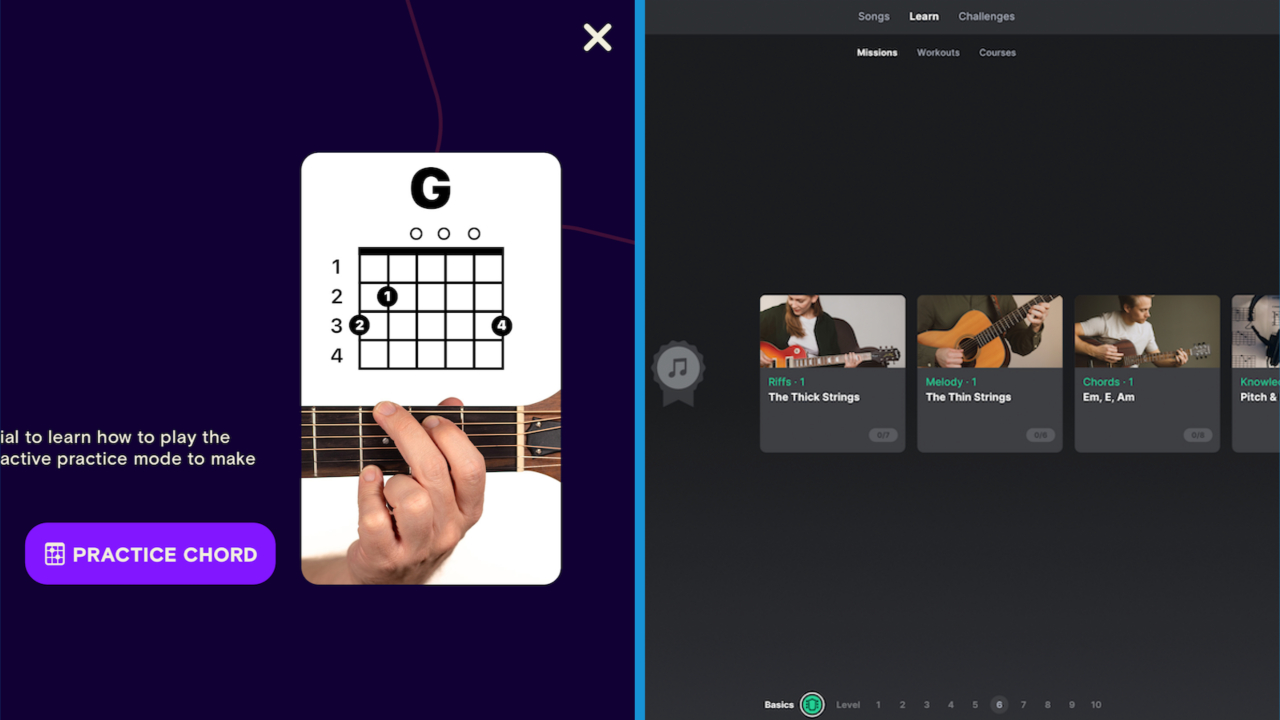
As mentioned above, it takes a little time and effort to get to grips with navigating Yousician, but our advice is to stick with it because it will all make sense in the end. We’ll try to explain.
At its topmost level Yousician has three main sections: Songs, Learn and Challenges. Songs is probably positioned first because the prospect of playing our favorite tracks is usually what gets us excited about learning the guitar in the first place. However, let’s skip that section for a minute and start with Learn. After all, you can’t play a song until you’ve done a little learning, and it’s under this section that the Learning Path lives.
The Learn section has three subsections: Missions, Workouts and Courses. While the obvious place for the Learning Path to sit is under Courses, you’ll find it instead under the somewhat ambiguously named Missions section. Courses is where you’ll find artist specific studies, while Workouts are exercises designed to hone your skills in specific techniques such as fingerpicking, as well as tackling scales, chords and arpeggios.
Back to the primary menu, Songs is pretty self-explanatory while Challenges are pieces designed to test you and your fellow Yousician members in a bout of friendly competition.
Simply Guitar is much easier to find your way around, simply because it’s not as feature rich. There are just three sections: Courses, Songs and Chords. Sensibly, the Course Path resides in the Courses section.
Winner: Once again, Simply Guitar takes the lead here because it’s more immediate.
Simply Guitar vs Yousician: Core content
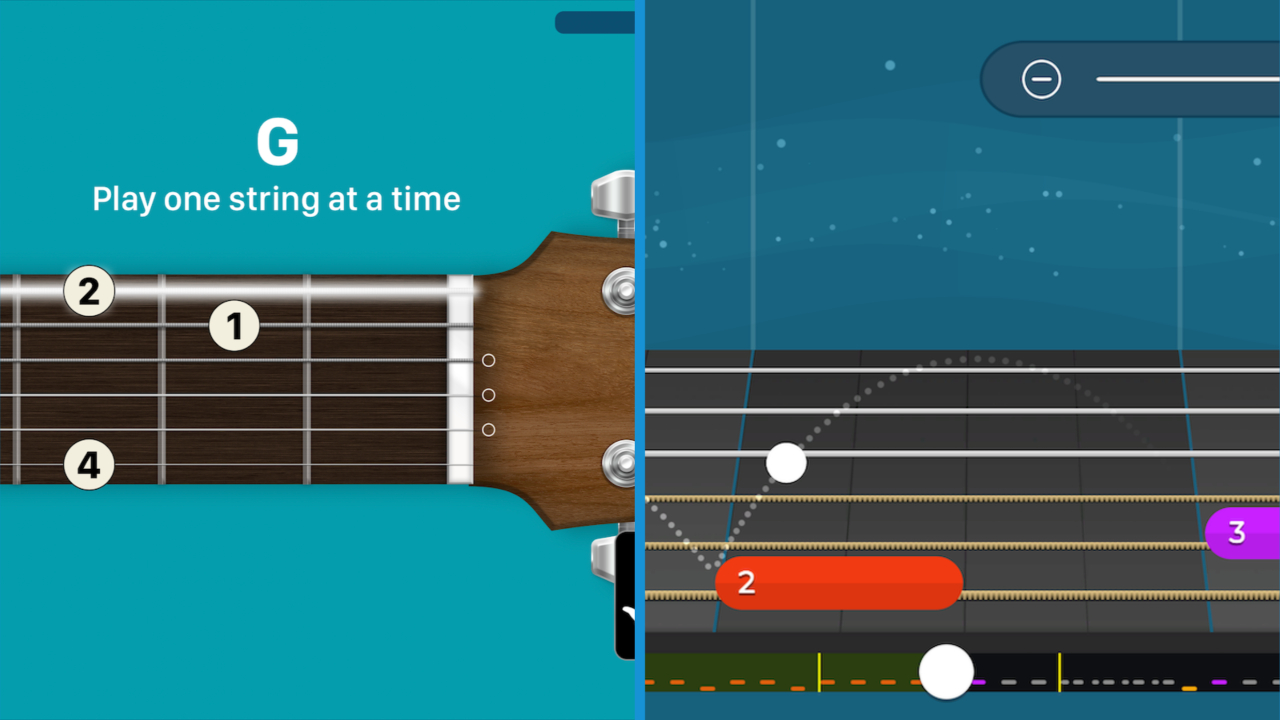
At the heart of both apps are their educational pathways and their song libraries. Let’s find out how they stack up before moving on to other content.
Yousician’s Learning Path comprises a string of separate Missions, its name for a group of closely related tutorials, songs and videos. Think of them as chapters in your guitar playing journey that become progressively harder. Every Mission has a series of tasks that must be played through in order for you to complete it.
In addition, the Missions are themed and also assigned a difficulty level from one to 10. The themes include components such as chord & rhythm accompaniment, melody, riff & lead work and music theory. The idea is that you can either work your way through the Missions and their associated tasks consecutively, taking in a broad range of themed material as you go, or you can stick to a particular theme. For example, if you’re desperate to brush up your lead skills at the expense of your rhythm work, then you could just pick out the melody, riffs & lead themed lessons.
However you choose to progress through the Learning Path you’ll be seeing a lot of Yousician’s animated fretboard. There is the occasional video, but most of the time you’ll be playing along with this brightly colored conveyor belt of notes. The fretted positions are colour-coded, to show you the correct fingering, and will turn green if you sound one successfully or red if you miss one. Words of encouragement, such as ‘Good’ and ‘Perfect’, will pop up if you fret the right note at roughly the right time.
Usually towards the end of each Mission there will be a song or two to complete. Play them well and you’ll amass points that might just put you at the top of Yousician’s Leaderboard. Here you can benchmark your performance against Yousician’s entire membership, or just against fellow Yousician guitarists who you choose to follow. This is a superb way to cultivate competition between friends or classmates, and a real incentive to practise that little bit harder.
To help bolster those scores, the songs can first be played in Practice mode, which lets you slow the track down, repeat sections and so on. When you’re ready, switch to Performance mode and watch those points soar.
How much content is there? Work through all Yousician’s Missions, Tasks and Levels and you will have completed more than 1,000 lessons.
Simply Guitar’s Course Path works in a similar way to Yousician’s path but is slightly simpler, which is fitting. Found under the Courses menu, it too is a string of episodes that become progressively more difficult.
You can choose one of two sub-paths on the Course Path or mix and match between them to suit your intentions and ambitions. They are the Lead Path, which is colored blue, and the Chords Path, which is colored pink.
Choose the Lead Path if you want to focus on melodies, riffs and lead playing techniques or go for the Chords Path if you would rather learn chords, chord progressions and strumming patterns.
Each pathway offers a significant amount of content, with the Chords Path currently offering more lessons than the Lead Path. However, Simply Guitar regularly uploads new course content, so this balance could change at any time.
They’re not paths as such, but you’ll also discover courses colored purple that teach skills which are equally vital across both lead and chord work.
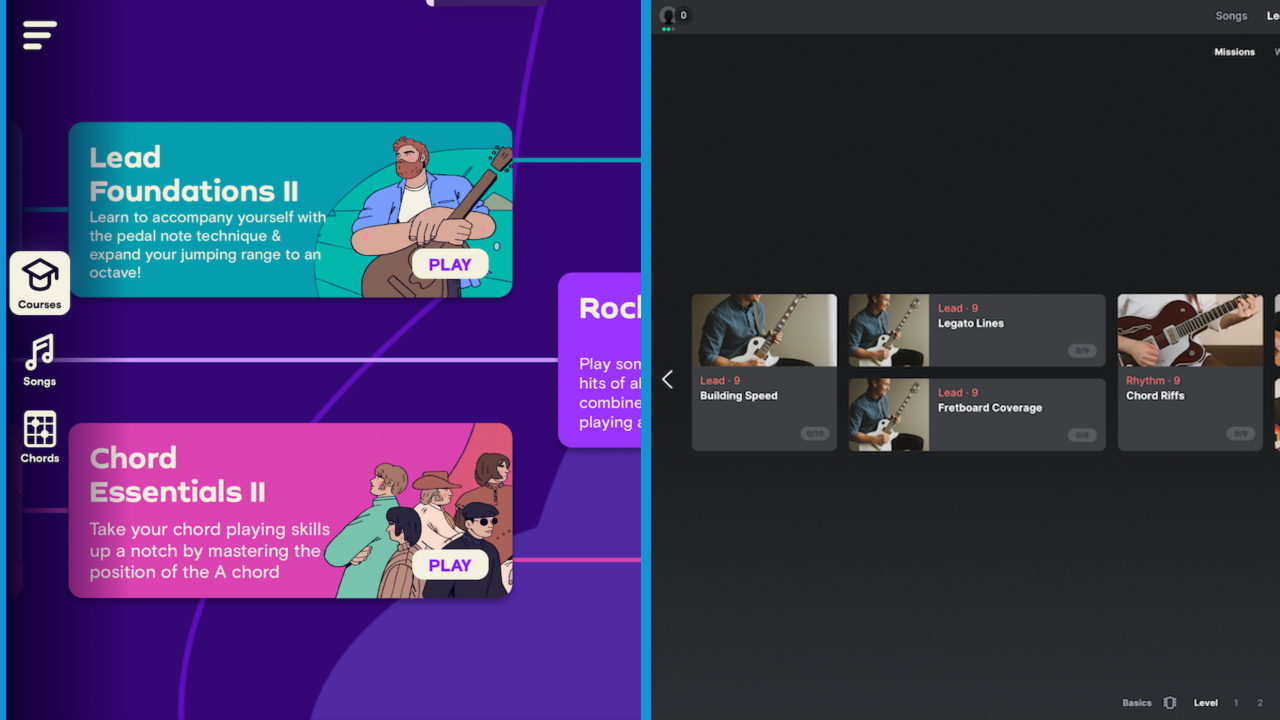
Like Yousician, Simply Guitar features some video content within its courses, but most of the time you’ll be using its animated fretboard. Once again, this is a conveyor belt of frets and notes with the fingering clearly marked, however it behaves slightly differently.
If you make a single error, Simply Guitar will let it pass but make a few mistakes in a row and the app will rewind a bar or two to give you the opportunity to play it again. You can also turn on Practice Mode to loop any sections that you are finding difficult, and though you cannot slow the tempo as such, Simply Guitar will wait for you to fret the right note before moving on.
Simply Guitar presents plenty of lesson content for the beginner guitarist, but there’s less here than you’ll find on Yousician.
Both applications constantly reward your efforts with green tick marks, gold stars, points and stirring messages of encouragement. You’re made to feel rather triumphant…
Simply Guitar’s song library is organised by pathway and course level which makes it easy to find, for example, songs that relate to its Chord Essentials III course. There is also a basic search bar that enables you to search for a term such as ‘Elvis’, but you cannot filter songs by genre or any other criteria, which is frustrating.
Its library comprises hundreds of songs, with an excellent mix of the classic, such as Jefferson Airplane’s Somebody to Love, and the contemporary, such as Blinding Lights by The Weeknd. Genres are limited to mostly rock and pop, so you’ll find very little jazz or classical here.
Modern pop icons are, however, very well represented, which will please fans of Ed Sheeran and Adele.
Yousician’s collection of songs is much larger and more comprehensive than Simply Guitar’s. It’s better catalogued too, which makes it a breeze to filter by artist, genre, level of difficulty, most played and so on.
There are plenty of classics here, Hey Joe by Hendrix for example, and lots and lots of contemporary artists. Once again, Ed Sheeran fans won’t be disappointed.
Genre’s such as jazz, country, Latin and classical are also vastly better represented.
Winner: It’s Yousician’s turn to fight back. It offers a much broader level of content than Simply Guitar.
Simply Guitar vs Yousician: Skill level?
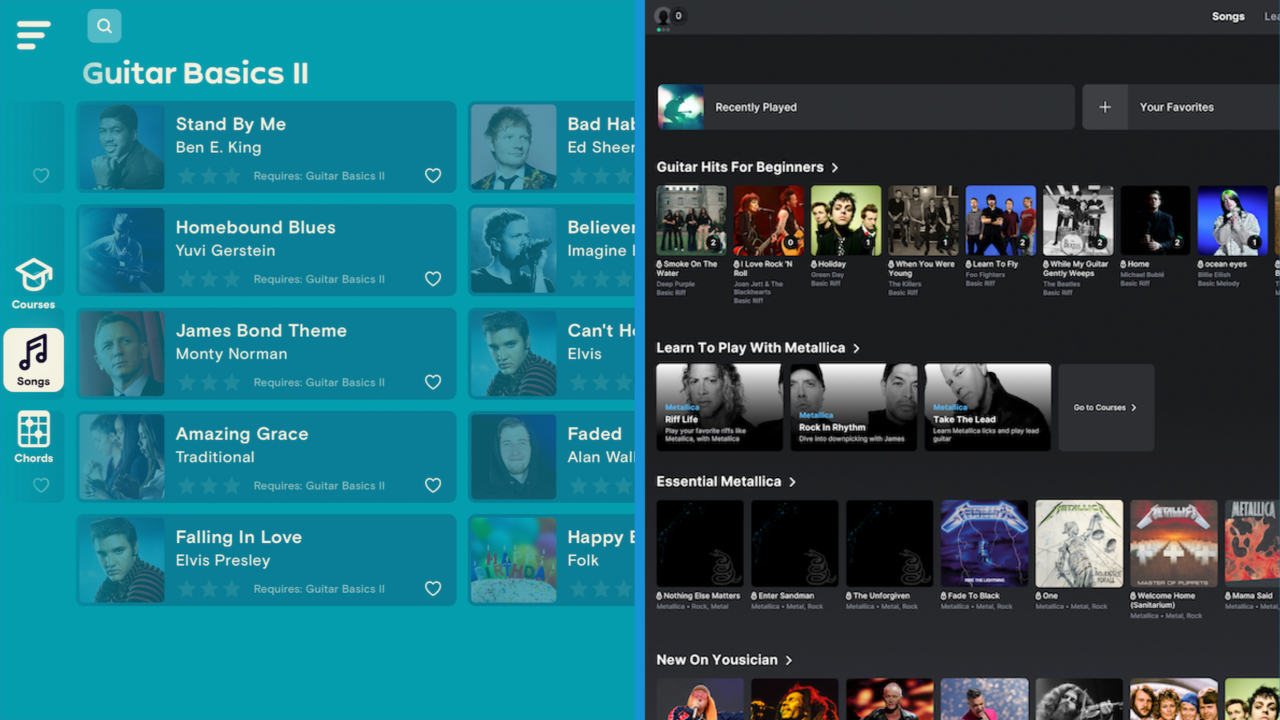
Both platforms are truly excellent for complete beginners. They’re exceptionally good at holding your hand through those first bewildering weeks of blistered fingertips and confused mnemonics. You’ll genuinely start to believe that ‘every amateur does get better eventually’ (EADGBE).
Simply Guitar will keep most newbies busy for months, but after that it begins to run out of steam. For example, when we conducted this review the last lesson in the Chords path was only just introducing barre chords, and most of the songs were heavily simplified versions of the originals.
That said, it’s worth acknowledging that Simply Guitar is uploading new content all the time, so we’re hopeful that the app will cover more advanced topics in the future.
Yousician goes quite a bit further. It too is fantastic for beginner guitarists, but your journey won’t end until you’re proficient at intermediate-level skills such as lead palm muting, and funk rhythm playing. It even dips a toe into alternate tunings. So, while these are hardly advanced skills, you will finish your months with Yousician as a solid intermediate player.
Its song library includes a good number of tracks that are genuinely challenging to play too, but if you are on the lower-tier Premium subscription you’ll only have access to Yousician-penned material, rather than any familiar famous tunes.
Winner: Yousician has pushed ahead again. Both serve beginners well, but currently only Yousician caters for the intermediate player.
Simply Guitar vs Yousician: Additional features
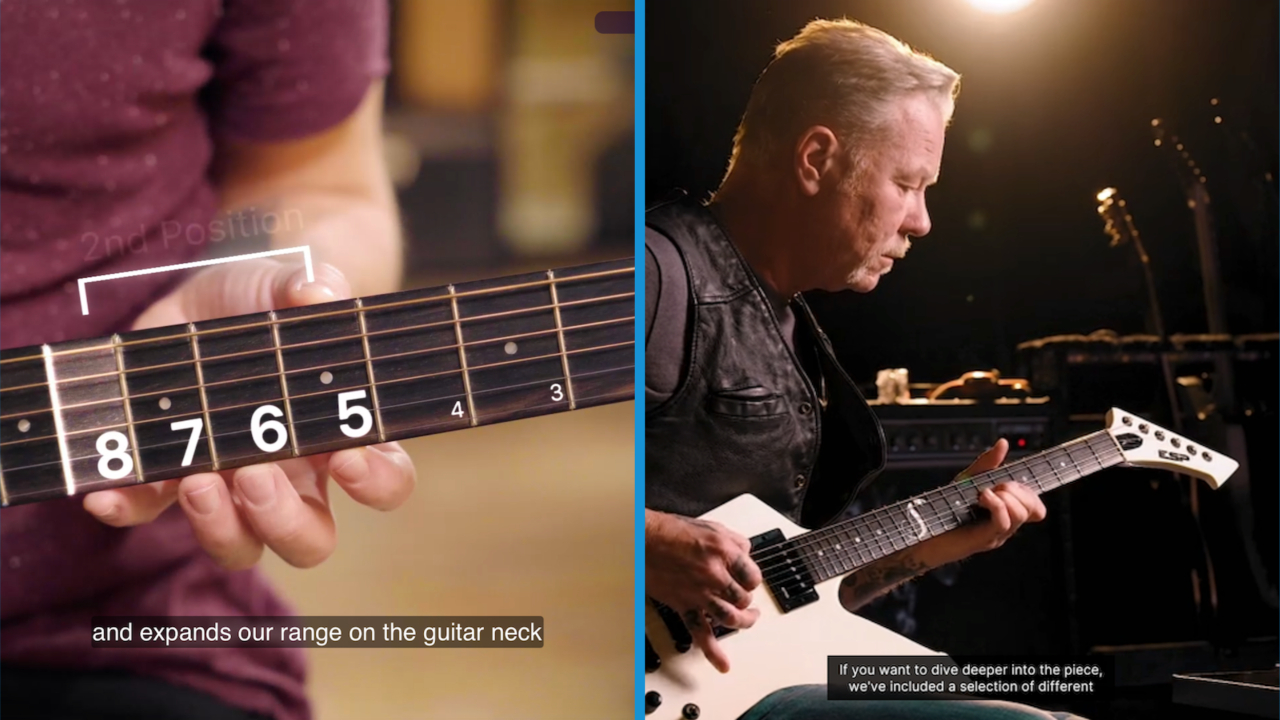
Yousician boasts two major features that Simply Guitar cannot equal. Firstly, there’s the facility to follow and be followed by other members of the Yousician community, enabling you to compete against them in its weekly challenges and other tasks.
It’s possible to restrict results to any size group, which makes it a wonderful way for a family, a class or just a handful of mates to keep in touch with each other’s progress. And, of course, to annihilate them at every opportunity!
Second, it has recently introduced artist-taught courses. The portfolio is small but growing, and you can already learn with big-hitters Metallica, Juanes and Jason Mraz. We expect this roster to grow.
If you sign up for either of Yousician’s Premium+ subscriptions you’ll also be given full access to the learning paths and lesson material for bass, piano, ukulele and singing as well as guitar. For beginners, starting with just the one instrument is probably enough, but intermediate players may find it useful to branch out into bass techniques. There’s also no better way to learn music theory than by taking piano lessons, and singer-songwriters will adore the singing lessons.
Sign up to its Premium+ Family subscription and up to four members of your family can join you in the learning process.
Simply Guitar offers five additional membership profiles with its Premium membership, and throws in its excellent Simply Piano app for free too. Incidentally, Simply Piano, which pre-dates Simply Guitar, is a more comprehensive learning platform that may hint at the way the guitar app will develop over time.
Simply Guitar makes a lot of noise about its Facebook community, but the fact is, Yousician is well-represented on the socials too.
Winner: Yousician takes it. The community features, and its artist-taught courses, can’t be matched by Simply Guitar.
Simply Guitar vs Yousician: Verdict
Yousician and Simply Guitar both provide a fun and genuinely effective environment for beginners to learn how to play the guitar. If you’ve tried more traditional methods in the past and failed, then it’s definitely worth giving either platform a try. It’s very hard to become disheartened or disillusioned with your playing when you’re logged into Yousician or Simply Guitar.
Once you’ve successfully navigated Yousician’s interface a couple of times you’ll find it offers more breadth and depth than Simply Guitar. Its community features and the artist courses are neat touches too.
Simply Guitar counters with, well, simplicity. We also love that its animated fretboard will rewind when you mess up, giving you another bite of the cherry.
Comparing costs, Yousician works out cheaper for a single user, but Simply Guitar will be less expensive for a family. Simply Piano is a super benefit to have for free, unless you want to play bass, in which case Yousician is the more obvious choice.
Let’s face it, both platforms are substantially cheaper than private tuition, and in some cases more fun, so we’re confident that beginners will be more than satisfied with either. On balance, we recommend Yousician, purely on the basis that it will take you further down the path of becoming a competent guitarist.
Related buyer's guides
- Best acoustic guitars for beginners: 10 easy acoustic strummers
- Best beginner electric guitars: kickstart your musical journey
- Best guitars for kids: top electric and acoustic guitars for children
- Guitar accessories for beginners and beginner guitar gear essentials
When Simon's childhood classical guitar teacher boasted he 'enjoyed a challenge', the poor man had no idea how much he'd underestimated the scale of the task ahead. Despite Simon's lack of talent, the experience did spark a lifelong passion for music. His classical guitar was discarded for an electric, then a room full of electrics before Simon discovered the joys of keys. Against all odds, Simon somehow managed to blag a career as a fashion journalist, but he's now more suitably employed writing for Guitar World and MusicRadar. When not writing or playing, he can be found terrifying himself on his mountain bike.
“There are so many sounds to be discovered when you get away from using a pick”: Jared James Nichols shows you how to add “snap, crackle and pop” to your playing with banjo rolls and string snaps
Don't let chord inversions bamboozle you. It's simply the case of shuffling the notes around


![A black-and-white action shot of Sergeant Thunderhoof perform live: [from left] Mark Sayer, Dan Flitcroft, Jim Camp and Josh Gallop](https://cdn.mos.cms.futurecdn.net/am3UhJbsxAE239XRRZ8zC8.jpg)







